HMG7200 Public Health: Analyzing the Health Belief Model Theory
VerifiedAdded on 2023/01/05
|6
|1548
|3
Essay
AI Summary
This essay provides an analysis of the Health Belief Model (HBM) within the context of public health. It begins with an introduction to health promotion theories and a rationale for selecting the HBM. The essay then delves into the origins of the model, tracing its development to social scientists in the U.S. Public Health Service in the 1950s and its connection to addressing poor health attitudes. The core constructs of the HBM, including perceived susceptibility, severity, benefits, barriers, cues to action, and self-efficacy, are discussed in detail. The essay also explores the application of the HBM in various health promotion initiatives, such as smoking cessation, breast cancer screening, and substance abuse prevention. While acknowledging the model's utility in fostering positive health behavior changes, the essay critically examines its limitations, particularly its neglect of social, economic, and cultural factors that can influence the adoption of recommended behaviors. In conclusion, the essay emphasizes the widespread use of the HBM in designing health promotion programs but cautions against overlooking potential barriers that may hinder their effectiveness.
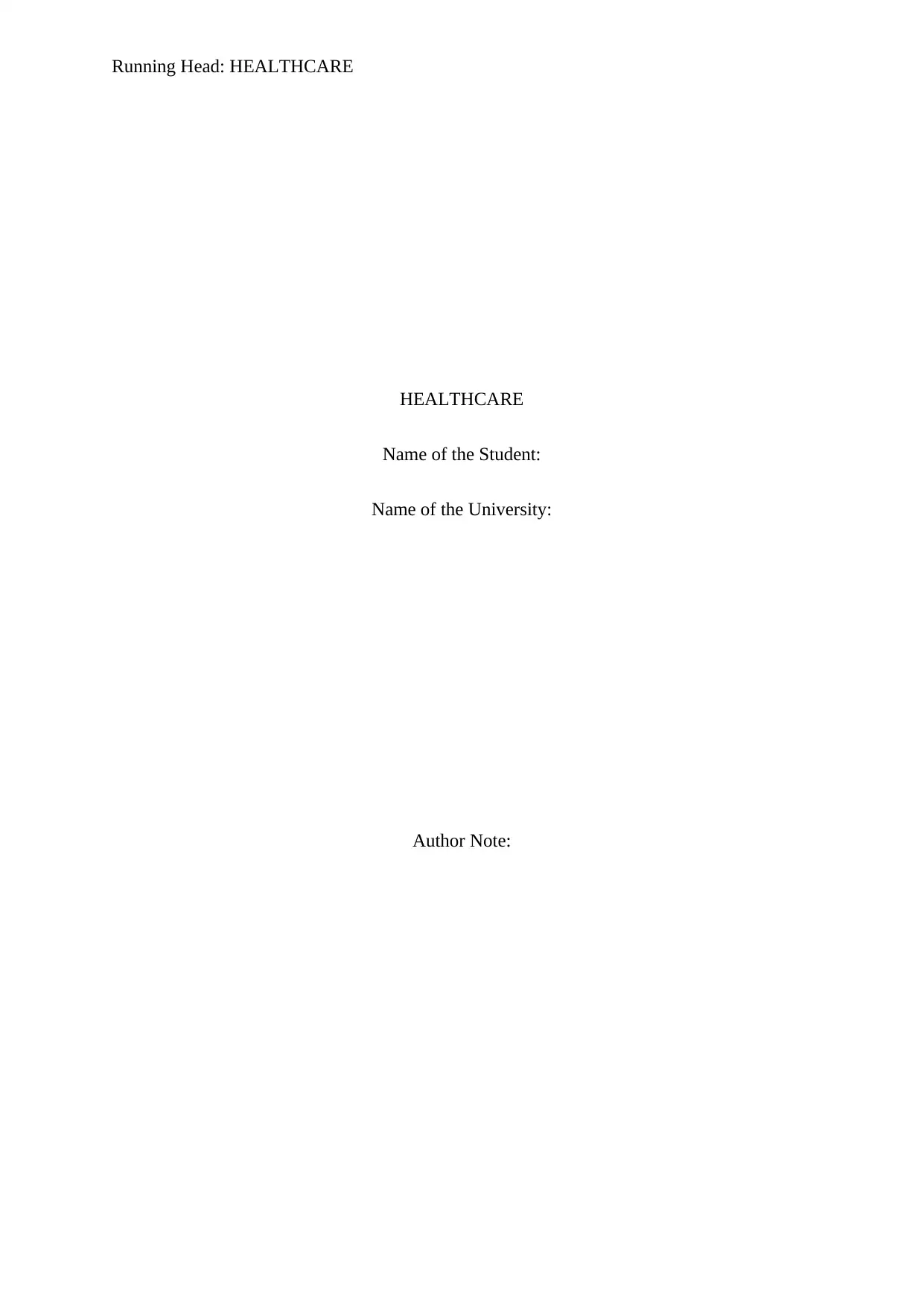
Running Head: HEALTHCARE
HEALTHCARE
Name of the Student:
Name of the University:
Author Note:
HEALTHCARE
Name of the Student:
Name of the University:
Author Note:
Paraphrase This Document
Need a fresh take? Get an instant paraphrase of this document with our AI Paraphraser
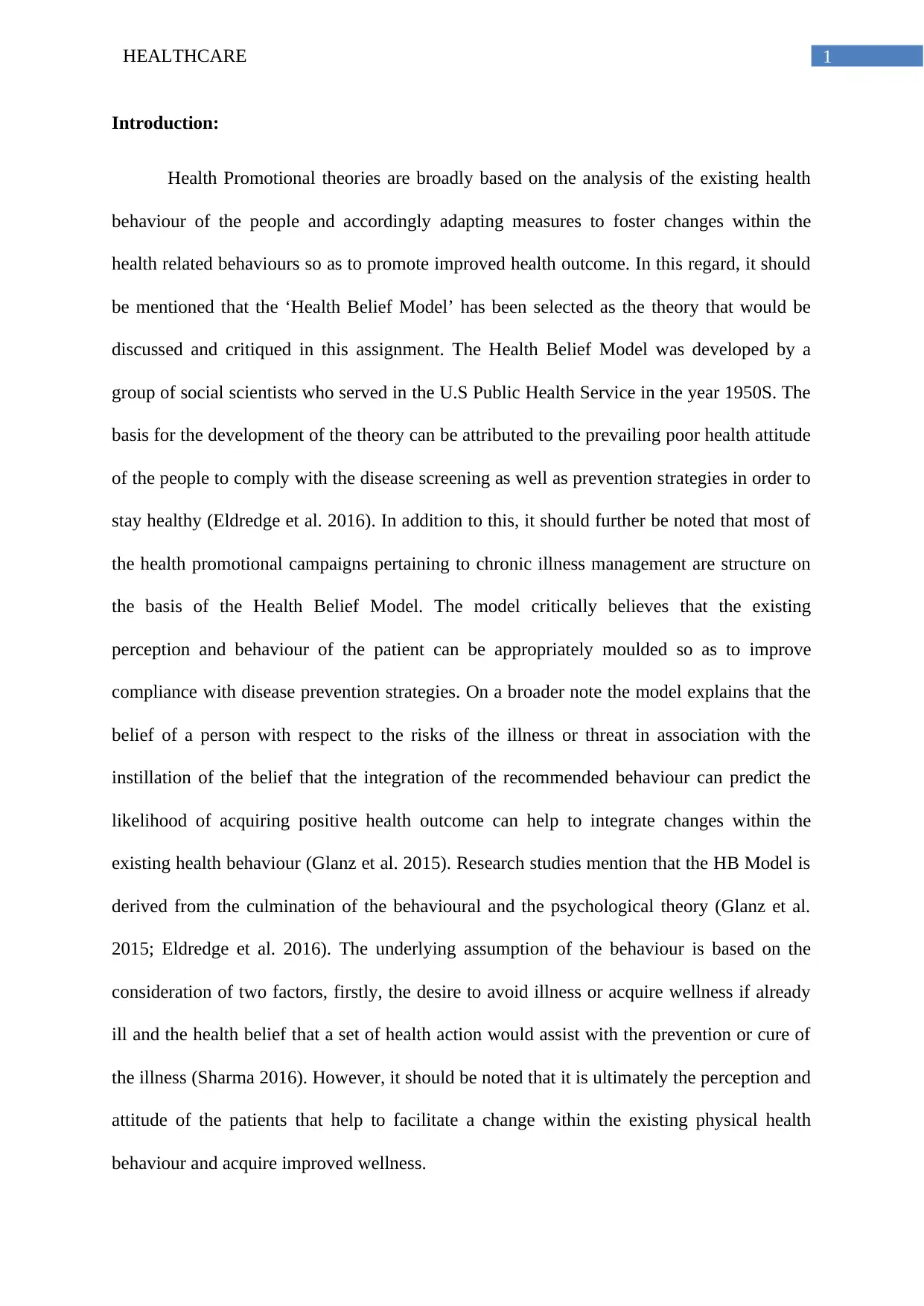
1HEALTHCARE
Introduction:
Health Promotional theories are broadly based on the analysis of the existing health
behaviour of the people and accordingly adapting measures to foster changes within the
health related behaviours so as to promote improved health outcome. In this regard, it should
be mentioned that the ‘Health Belief Model’ has been selected as the theory that would be
discussed and critiqued in this assignment. The Health Belief Model was developed by a
group of social scientists who served in the U.S Public Health Service in the year 1950S. The
basis for the development of the theory can be attributed to the prevailing poor health attitude
of the people to comply with the disease screening as well as prevention strategies in order to
stay healthy (Eldredge et al. 2016). In addition to this, it should further be noted that most of
the health promotional campaigns pertaining to chronic illness management are structure on
the basis of the Health Belief Model. The model critically believes that the existing
perception and behaviour of the patient can be appropriately moulded so as to improve
compliance with disease prevention strategies. On a broader note the model explains that the
belief of a person with respect to the risks of the illness or threat in association with the
instillation of the belief that the integration of the recommended behaviour can predict the
likelihood of acquiring positive health outcome can help to integrate changes within the
existing health behaviour (Glanz et al. 2015). Research studies mention that the HB Model is
derived from the culmination of the behavioural and the psychological theory (Glanz et al.
2015; Eldredge et al. 2016). The underlying assumption of the behaviour is based on the
consideration of two factors, firstly, the desire to avoid illness or acquire wellness if already
ill and the health belief that a set of health action would assist with the prevention or cure of
the illness (Sharma 2016). However, it should be noted that it is ultimately the perception and
attitude of the patients that help to facilitate a change within the existing physical health
behaviour and acquire improved wellness.
Introduction:
Health Promotional theories are broadly based on the analysis of the existing health
behaviour of the people and accordingly adapting measures to foster changes within the
health related behaviours so as to promote improved health outcome. In this regard, it should
be mentioned that the ‘Health Belief Model’ has been selected as the theory that would be
discussed and critiqued in this assignment. The Health Belief Model was developed by a
group of social scientists who served in the U.S Public Health Service in the year 1950S. The
basis for the development of the theory can be attributed to the prevailing poor health attitude
of the people to comply with the disease screening as well as prevention strategies in order to
stay healthy (Eldredge et al. 2016). In addition to this, it should further be noted that most of
the health promotional campaigns pertaining to chronic illness management are structure on
the basis of the Health Belief Model. The model critically believes that the existing
perception and behaviour of the patient can be appropriately moulded so as to improve
compliance with disease prevention strategies. On a broader note the model explains that the
belief of a person with respect to the risks of the illness or threat in association with the
instillation of the belief that the integration of the recommended behaviour can predict the
likelihood of acquiring positive health outcome can help to integrate changes within the
existing health behaviour (Glanz et al. 2015). Research studies mention that the HB Model is
derived from the culmination of the behavioural and the psychological theory (Glanz et al.
2015; Eldredge et al. 2016). The underlying assumption of the behaviour is based on the
consideration of two factors, firstly, the desire to avoid illness or acquire wellness if already
ill and the health belief that a set of health action would assist with the prevention or cure of
the illness (Sharma 2016). However, it should be noted that it is ultimately the perception and
attitude of the patients that help to facilitate a change within the existing physical health
behaviour and acquire improved wellness.
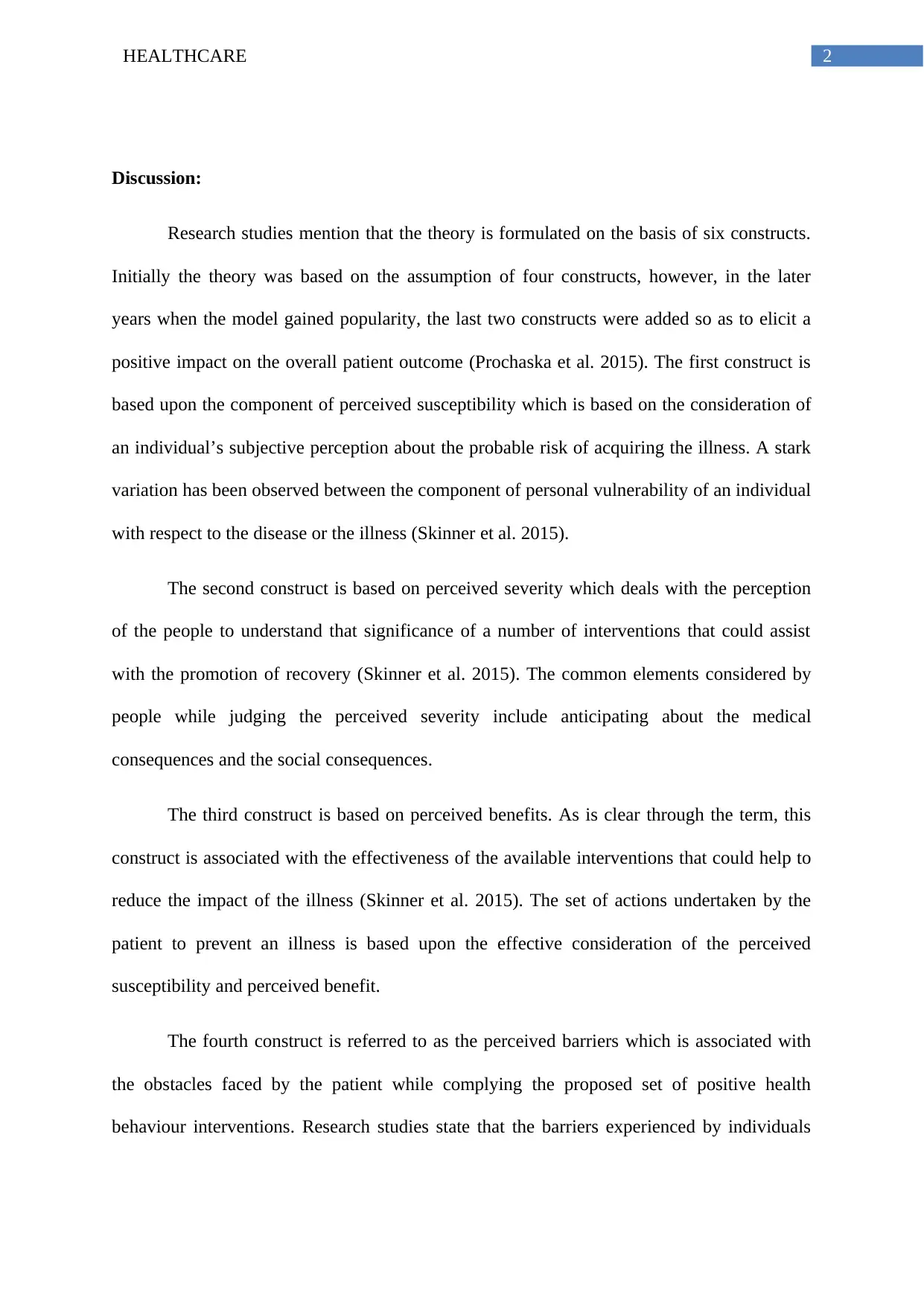
2HEALTHCARE
Discussion:
Research studies mention that the theory is formulated on the basis of six constructs.
Initially the theory was based on the assumption of four constructs, however, in the later
years when the model gained popularity, the last two constructs were added so as to elicit a
positive impact on the overall patient outcome (Prochaska et al. 2015). The first construct is
based upon the component of perceived susceptibility which is based on the consideration of
an individual’s subjective perception about the probable risk of acquiring the illness. A stark
variation has been observed between the component of personal vulnerability of an individual
with respect to the disease or the illness (Skinner et al. 2015).
The second construct is based on perceived severity which deals with the perception
of the people to understand that significance of a number of interventions that could assist
with the promotion of recovery (Skinner et al. 2015). The common elements considered by
people while judging the perceived severity include anticipating about the medical
consequences and the social consequences.
The third construct is based on perceived benefits. As is clear through the term, this
construct is associated with the effectiveness of the available interventions that could help to
reduce the impact of the illness (Skinner et al. 2015). The set of actions undertaken by the
patient to prevent an illness is based upon the effective consideration of the perceived
susceptibility and perceived benefit.
The fourth construct is referred to as the perceived barriers which is associated with
the obstacles faced by the patient while complying the proposed set of positive health
behaviour interventions. Research studies state that the barriers experienced by individuals
Discussion:
Research studies mention that the theory is formulated on the basis of six constructs.
Initially the theory was based on the assumption of four constructs, however, in the later
years when the model gained popularity, the last two constructs were added so as to elicit a
positive impact on the overall patient outcome (Prochaska et al. 2015). The first construct is
based upon the component of perceived susceptibility which is based on the consideration of
an individual’s subjective perception about the probable risk of acquiring the illness. A stark
variation has been observed between the component of personal vulnerability of an individual
with respect to the disease or the illness (Skinner et al. 2015).
The second construct is based on perceived severity which deals with the perception
of the people to understand that significance of a number of interventions that could assist
with the promotion of recovery (Skinner et al. 2015). The common elements considered by
people while judging the perceived severity include anticipating about the medical
consequences and the social consequences.
The third construct is based on perceived benefits. As is clear through the term, this
construct is associated with the effectiveness of the available interventions that could help to
reduce the impact of the illness (Skinner et al. 2015). The set of actions undertaken by the
patient to prevent an illness is based upon the effective consideration of the perceived
susceptibility and perceived benefit.
The fourth construct is referred to as the perceived barriers which is associated with
the obstacles faced by the patient while complying the proposed set of positive health
behaviour interventions. Research studies state that the barriers experienced by individuals
⊘ This is a preview!⊘
Do you want full access?
Subscribe today to unlock all pages.

Trusted by 1+ million students worldwide
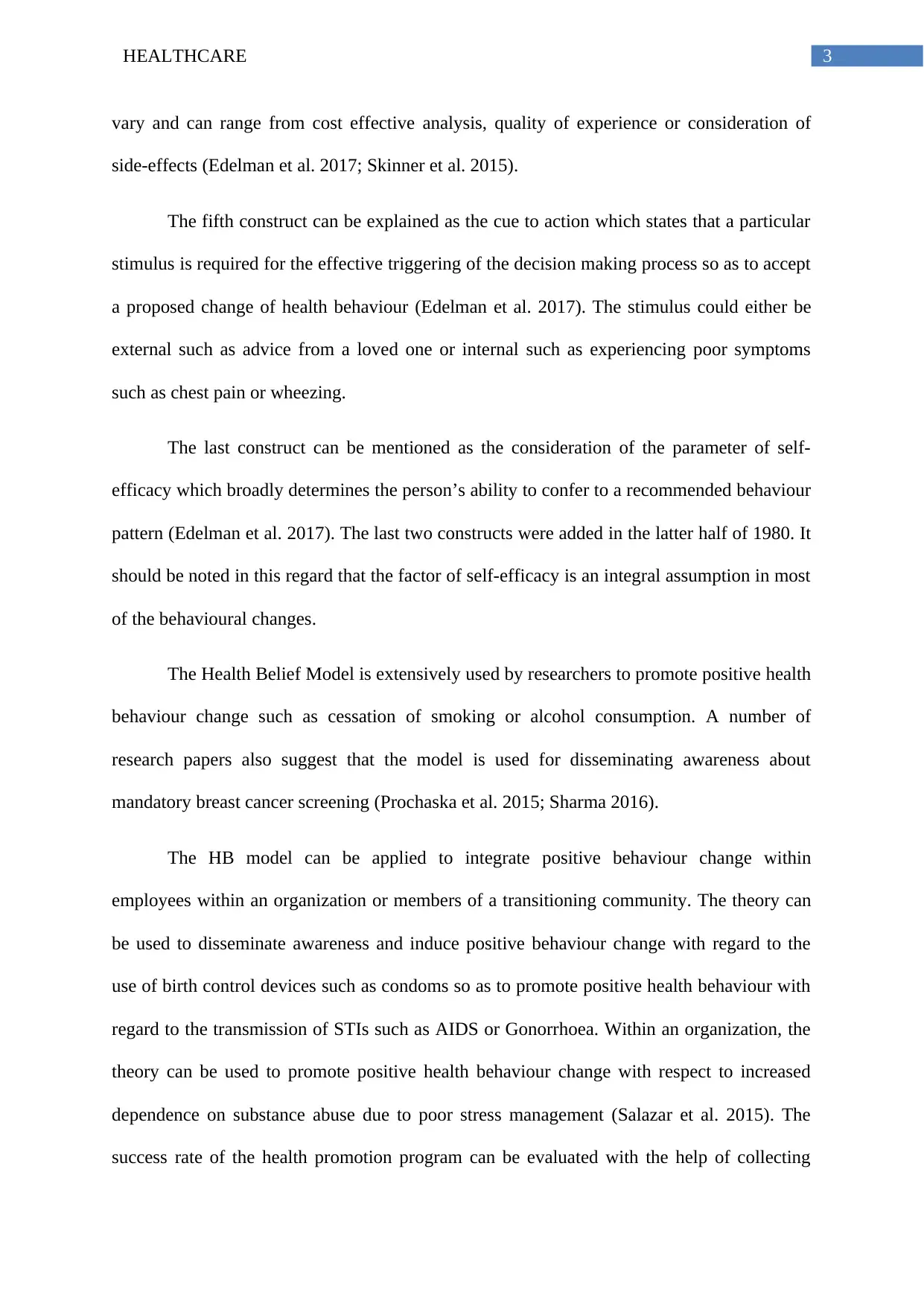
3HEALTHCARE
vary and can range from cost effective analysis, quality of experience or consideration of
side-effects (Edelman et al. 2017; Skinner et al. 2015).
The fifth construct can be explained as the cue to action which states that a particular
stimulus is required for the effective triggering of the decision making process so as to accept
a proposed change of health behaviour (Edelman et al. 2017). The stimulus could either be
external such as advice from a loved one or internal such as experiencing poor symptoms
such as chest pain or wheezing.
The last construct can be mentioned as the consideration of the parameter of self-
efficacy which broadly determines the person’s ability to confer to a recommended behaviour
pattern (Edelman et al. 2017). The last two constructs were added in the latter half of 1980. It
should be noted in this regard that the factor of self-efficacy is an integral assumption in most
of the behavioural changes.
The Health Belief Model is extensively used by researchers to promote positive health
behaviour change such as cessation of smoking or alcohol consumption. A number of
research papers also suggest that the model is used for disseminating awareness about
mandatory breast cancer screening (Prochaska et al. 2015; Sharma 2016).
The HB model can be applied to integrate positive behaviour change within
employees within an organization or members of a transitioning community. The theory can
be used to disseminate awareness and induce positive behaviour change with regard to the
use of birth control devices such as condoms so as to promote positive health behaviour with
regard to the transmission of STIs such as AIDS or Gonorrhoea. Within an organization, the
theory can be used to promote positive health behaviour change with respect to increased
dependence on substance abuse due to poor stress management (Salazar et al. 2015). The
success rate of the health promotion program can be evaluated with the help of collecting
vary and can range from cost effective analysis, quality of experience or consideration of
side-effects (Edelman et al. 2017; Skinner et al. 2015).
The fifth construct can be explained as the cue to action which states that a particular
stimulus is required for the effective triggering of the decision making process so as to accept
a proposed change of health behaviour (Edelman et al. 2017). The stimulus could either be
external such as advice from a loved one or internal such as experiencing poor symptoms
such as chest pain or wheezing.
The last construct can be mentioned as the consideration of the parameter of self-
efficacy which broadly determines the person’s ability to confer to a recommended behaviour
pattern (Edelman et al. 2017). The last two constructs were added in the latter half of 1980. It
should be noted in this regard that the factor of self-efficacy is an integral assumption in most
of the behavioural changes.
The Health Belief Model is extensively used by researchers to promote positive health
behaviour change such as cessation of smoking or alcohol consumption. A number of
research papers also suggest that the model is used for disseminating awareness about
mandatory breast cancer screening (Prochaska et al. 2015; Sharma 2016).
The HB model can be applied to integrate positive behaviour change within
employees within an organization or members of a transitioning community. The theory can
be used to disseminate awareness and induce positive behaviour change with regard to the
use of birth control devices such as condoms so as to promote positive health behaviour with
regard to the transmission of STIs such as AIDS or Gonorrhoea. Within an organization, the
theory can be used to promote positive health behaviour change with respect to increased
dependence on substance abuse due to poor stress management (Salazar et al. 2015). The
success rate of the health promotion program can be evaluated with the help of collecting
Paraphrase This Document
Need a fresh take? Get an instant paraphrase of this document with our AI Paraphraser
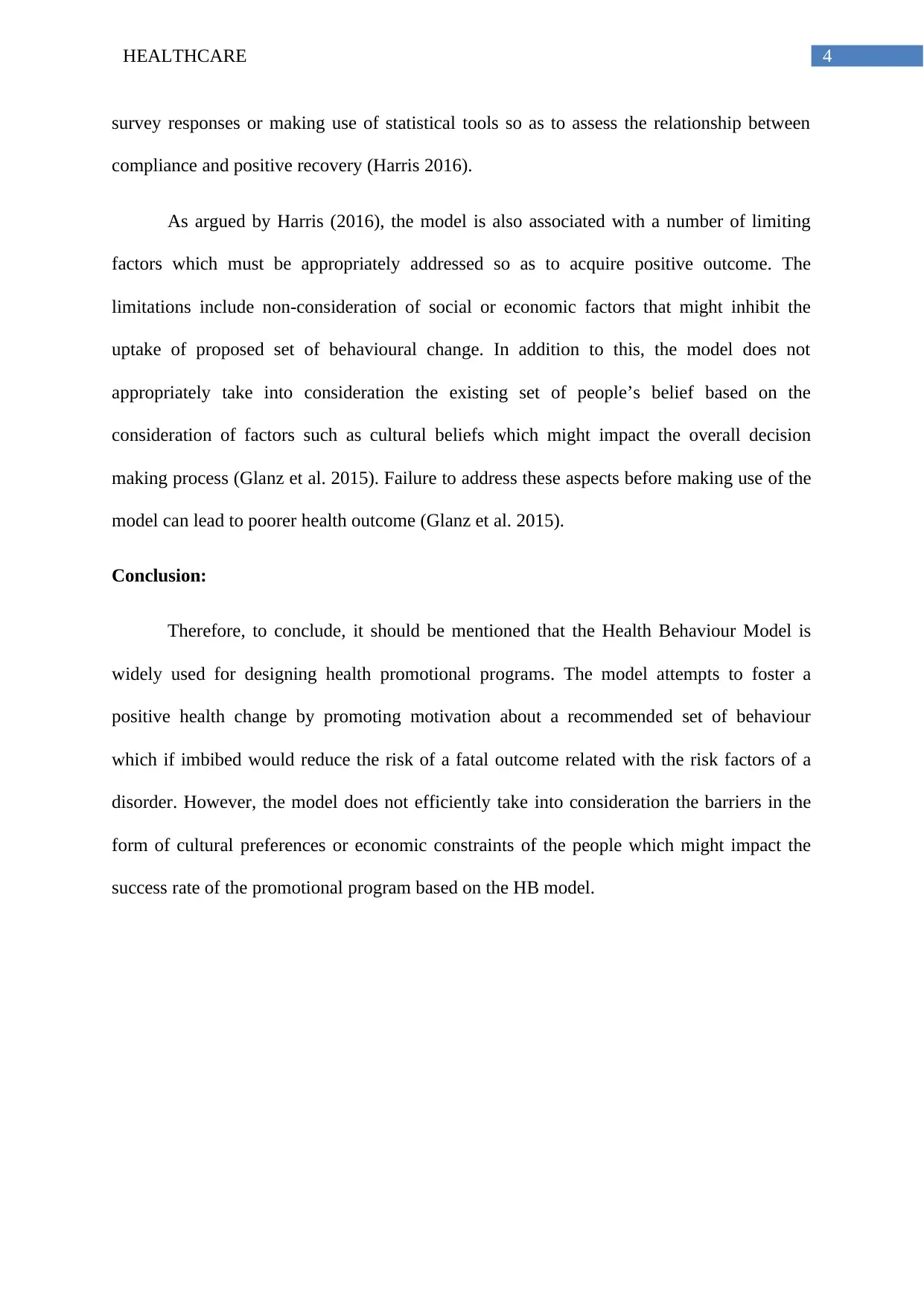
4HEALTHCARE
survey responses or making use of statistical tools so as to assess the relationship between
compliance and positive recovery (Harris 2016).
As argued by Harris (2016), the model is also associated with a number of limiting
factors which must be appropriately addressed so as to acquire positive outcome. The
limitations include non-consideration of social or economic factors that might inhibit the
uptake of proposed set of behavioural change. In addition to this, the model does not
appropriately take into consideration the existing set of people’s belief based on the
consideration of factors such as cultural beliefs which might impact the overall decision
making process (Glanz et al. 2015). Failure to address these aspects before making use of the
model can lead to poorer health outcome (Glanz et al. 2015).
Conclusion:
Therefore, to conclude, it should be mentioned that the Health Behaviour Model is
widely used for designing health promotional programs. The model attempts to foster a
positive health change by promoting motivation about a recommended set of behaviour
which if imbibed would reduce the risk of a fatal outcome related with the risk factors of a
disorder. However, the model does not efficiently take into consideration the barriers in the
form of cultural preferences or economic constraints of the people which might impact the
success rate of the promotional program based on the HB model.
survey responses or making use of statistical tools so as to assess the relationship between
compliance and positive recovery (Harris 2016).
As argued by Harris (2016), the model is also associated with a number of limiting
factors which must be appropriately addressed so as to acquire positive outcome. The
limitations include non-consideration of social or economic factors that might inhibit the
uptake of proposed set of behavioural change. In addition to this, the model does not
appropriately take into consideration the existing set of people’s belief based on the
consideration of factors such as cultural beliefs which might impact the overall decision
making process (Glanz et al. 2015). Failure to address these aspects before making use of the
model can lead to poorer health outcome (Glanz et al. 2015).
Conclusion:
Therefore, to conclude, it should be mentioned that the Health Behaviour Model is
widely used for designing health promotional programs. The model attempts to foster a
positive health change by promoting motivation about a recommended set of behaviour
which if imbibed would reduce the risk of a fatal outcome related with the risk factors of a
disorder. However, the model does not efficiently take into consideration the barriers in the
form of cultural preferences or economic constraints of the people which might impact the
success rate of the promotional program based on the HB model.
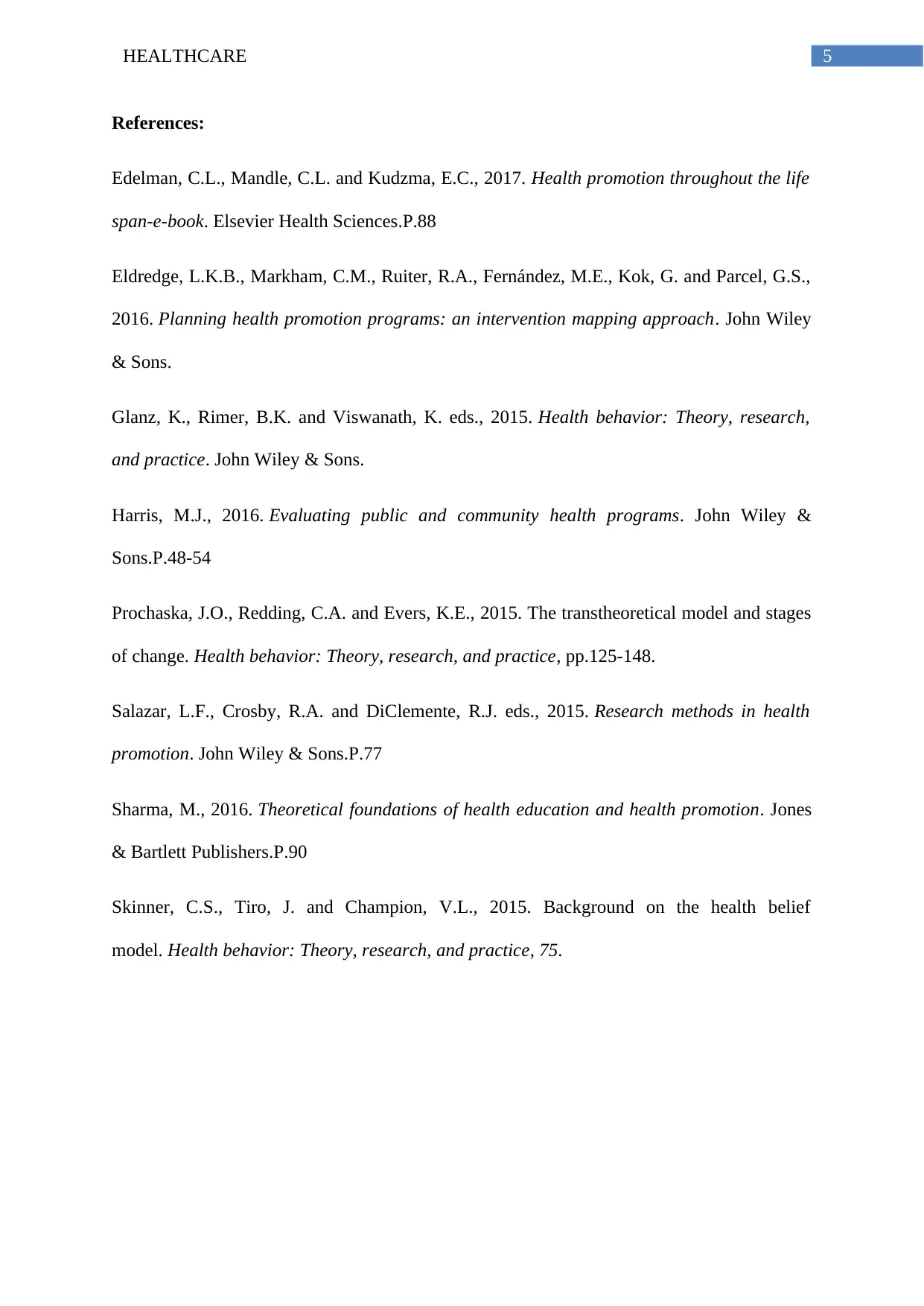
5HEALTHCARE
References:
Edelman, C.L., Mandle, C.L. and Kudzma, E.C., 2017. Health promotion throughout the life
span-e-book. Elsevier Health Sciences.P.88
Eldredge, L.K.B., Markham, C.M., Ruiter, R.A., Fernández, M.E., Kok, G. and Parcel, G.S.,
2016. Planning health promotion programs: an intervention mapping approach. John Wiley
& Sons.
Glanz, K., Rimer, B.K. and Viswanath, K. eds., 2015. Health behavior: Theory, research,
and practice. John Wiley & Sons.
Harris, M.J., 2016. Evaluating public and community health programs. John Wiley &
Sons.P.48-54
Prochaska, J.O., Redding, C.A. and Evers, K.E., 2015. The transtheoretical model and stages
of change. Health behavior: Theory, research, and practice, pp.125-148.
Salazar, L.F., Crosby, R.A. and DiClemente, R.J. eds., 2015. Research methods in health
promotion. John Wiley & Sons.P.77
Sharma, M., 2016. Theoretical foundations of health education and health promotion. Jones
& Bartlett Publishers.P.90
Skinner, C.S., Tiro, J. and Champion, V.L., 2015. Background on the health belief
model. Health behavior: Theory, research, and practice, 75.
References:
Edelman, C.L., Mandle, C.L. and Kudzma, E.C., 2017. Health promotion throughout the life
span-e-book. Elsevier Health Sciences.P.88
Eldredge, L.K.B., Markham, C.M., Ruiter, R.A., Fernández, M.E., Kok, G. and Parcel, G.S.,
2016. Planning health promotion programs: an intervention mapping approach. John Wiley
& Sons.
Glanz, K., Rimer, B.K. and Viswanath, K. eds., 2015. Health behavior: Theory, research,
and practice. John Wiley & Sons.
Harris, M.J., 2016. Evaluating public and community health programs. John Wiley &
Sons.P.48-54
Prochaska, J.O., Redding, C.A. and Evers, K.E., 2015. The transtheoretical model and stages
of change. Health behavior: Theory, research, and practice, pp.125-148.
Salazar, L.F., Crosby, R.A. and DiClemente, R.J. eds., 2015. Research methods in health
promotion. John Wiley & Sons.P.77
Sharma, M., 2016. Theoretical foundations of health education and health promotion. Jones
& Bartlett Publishers.P.90
Skinner, C.S., Tiro, J. and Champion, V.L., 2015. Background on the health belief
model. Health behavior: Theory, research, and practice, 75.
⊘ This is a preview!⊘
Do you want full access?
Subscribe today to unlock all pages.

Trusted by 1+ million students worldwide
1 out of 6
Related Documents
Your All-in-One AI-Powered Toolkit for Academic Success.
+13062052269
info@desklib.com
Available 24*7 on WhatsApp / Email
![[object Object]](/_next/static/media/star-bottom.7253800d.svg)
Unlock your academic potential
Copyright © 2020–2025 A2Z Services. All Rights Reserved. Developed and managed by ZUCOL.





